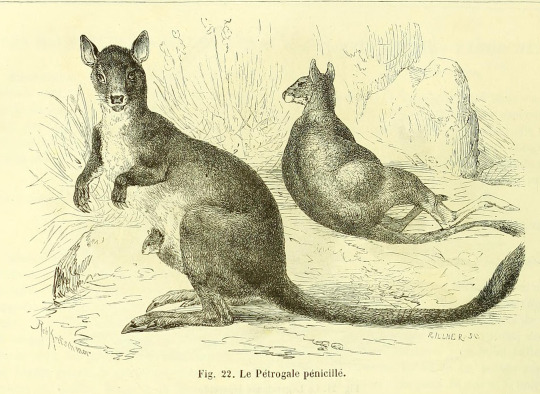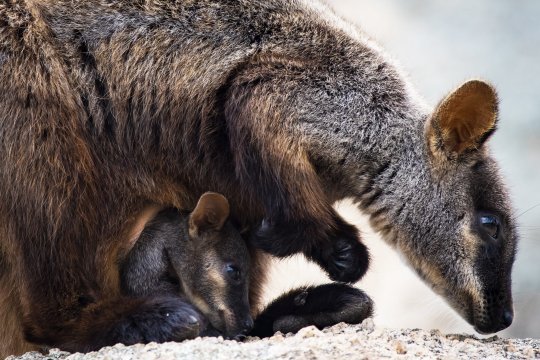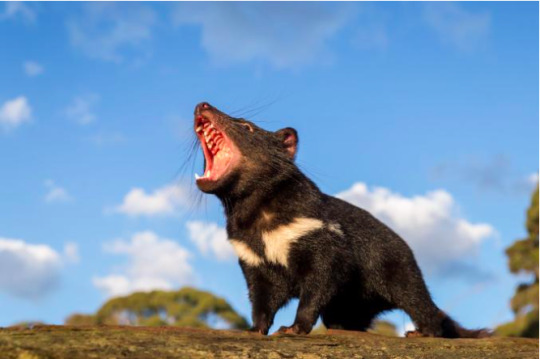#brush-tailed rock-wallaby
Text

La Vie des Animaux Illustrée. Written by Alfred Brehm. Illustration by Robert Kretschmer. 1869 French edition.
Internet Archive
52 notes
·
View notes
Photo

An endangered brush-tailed rock-wallaby (Petrogale penicillata) with joey perches on a rocky outcrop of the Mount Rothwell Biodiversity Interpretation Centre, Little River, Victoria.
Photo Credit: Annette Ruzicka
#annette ruzicka#photographer#australian geographic#brush-tailed rock-wallaby#petrogale penicillata#animal#mammal#wallaby#mount rothwell biodiversity interpretation centre#little river#victoria#australia#nature#wildlife
67 notes
·
View notes
Video
youtube
A Panoramic Paradise: Wollondilly Lookout in all its Glory
The picturesque Wollondilly lookout offers a breathtaking panorama of the eucalypt forests, sandstone cliffs, and mountain ranges that grace the Nattai National Park. From this vantage point, the hustle and bustle of suburbia and city life seem worlds away, as you immerse yourself in the awe-inspiring views of the park's majestic mountains and serene lakes.
Marvel at the extraordinary sandstone cliff ridges and lush eucalypt forests that adorn the park. This haven is not only a haven for nature enthusiasts but also a haven for birdwatchers, who may be fortunate enough to catch a glimpse of the park's diverse avian species. Additionally, keep your eyes peeled for the park's inhabitants, including the eastern grey kangaroos, wallaroos, brush-tailed rock wallabies, koalas, and owls.
For further exploration, be sure to peruse the informative board at the lookout, which provides a detailed map of the area and invaluable insights into the myriad of remarkable attractions that Nattai has to offer.
0 notes
Text
Also, I wanna look at marsupials.
Monito del Monte

What stands out to me is how many depictions show them wrapping their tails around things.


Also, that is some extreme smoll.
Southern Marsupial Mole

I can't find much depictions of it that aren't at least half submerged into the ground.

I gotta say, weirdly terrifying little man. Something about this guy just creeps me out a little.
Macrotis

Weird little guy.


Those tails are really neat. Also the face is great.
Thylacinidae

it went extinct :(
It's a really neat looking guy too.


like, look how big it could open its mouth. That's certainly a fucking thing.

Like, that is a really boi.
Numbat

Little man!!

And that tongue is fucking wild.

The pallet and design on this guy is just striking. I like the gradient and this thing really pulls off the stripes.
Kowari

Look at this little guy.

I think the proportions just stand out to me. Like, those big legs tiny arms big fucking tail.
Tiger Quoll

Those dots are cool. I also really like that tail.

Also, this thing is very cute.

Brush-Tailed Phascogale

The name doesn't lie, that does look like a duster.

Kultarr

These guys also have a really nice silhouette. Orb with tail.


Cuscus

That thing looks mildly uncanny.


Brush-Tailed Rock Wallaby


1 note
·
View note
Link
For the first time in 3,000 years, Tasmanian devils have returned to the wild. Conservation groups have reintroduced 26 of the mammals into a large sanctuary in Barrington Tops National Park, north of Sydney, in mainland Australia. During the 1990s, there were roughly 150,000 devils in the wild on the...
#Nature#Sustainability#1k- acre sanctuary#3k years#a large sanctuary#animal carcases#animals#Aussie Ark#Aussie Ark’s president#australia#australian#Australian island state#Australian native species#Australian sanctuary#Australian wild#Barrington Tops National Park#bone-crushing#brush-tailed rock wallabies#Chris Hemsworth#conservation groups#deadly mouth cancer#devil#eastern quolls#Elsa Pataky#endangered species#evil spirits#fenced sanctuary#Global Wildlife Conservation#high-pitch squeal#long-nosed
41 notes
·
View notes
Photo






Brush-tailed Rock-Wallaby at Taronga x
39 notes
·
View notes
Photo








🔎📚Data Visualization📚🔍
It's the middle of the spring semester and I've been neglecting to post things here recently. Part of the reason is because I have been swamped with things to do, projects to manage, and students to teach.
I've mostly finished one of these projects though! This project was on data visualization and how we can turn numbers into something moving and creative.
I chose to focus on the Australian wildfires of 2020. With such an immense amount of land burned, human life overturned, and wildlife threatened, those wildfires were a sobering start to a year that proved very difficult as a whole.
I wanted to highlight how wildlife can be impacted by fire without diving into something too complex so I worked with the Provisional list of animals requiring urgent management intervention released by the Australian department of Agriculture, Water, and the Environment in March of 2020.
This document highlights 119 animal species across 7 animal classes severely impacted by the wildfires, many of which were already endangered to begin with.
Each tree cookie consists of one animal class: Fish, Amphibian, Reptile, Mammal, Bird, Crustacean, and Insect. The image on each cookie is a silhouette of an endangered species endemic to Australia and affected by the fires. The images were created by burning gunpowder to cause a high heat sear across the wood. The rings were created using woodburning, and each full ring represents 5 species impacted by the fires.
Species images:
Nangur Spiny Skink
Orbost Spiny Crayfish
Western Ground Parrot
Brush Tailed Rock Wallaby
Northern Corroboree Frog
Flathead Galaxias
Alpine Stonefly
#art#data visualization#nature#wildlife#wildfire#mammals#birds#reptiles#amphibians#insects#crustaceans#fish#woodburning#gunpowder art#project#graduate school
13 notes
·
View notes
Photo

Tasmanian devils, known for their ferocious temperaments, have been plagued by a contagious facial cancer in recent decades.
Tasmanian devils return to mainland Australia for first time in 3,000 years
Scientists hope the scrappy predators' reintroduction can balance ecosystems ravaged by invasive species.
JASON BITTEL
OCTOBER 5, 2020
It’s been 3,000 years since the Tasmanian devil’s raspy shriek rang through the forests of mainland Australia. But now, thanks to a dogged reintroduction effort, 26 of these endangered tiny terrors have returned.
No bigger than a lapdog, these marsupials are famous for their ferocity and powerful jaws, which can reduce large carcasses to smithereens in minutes. But in the 1990s, the species was hit with a contagious and deadly mouth cancer, causing its only remaining wild population, on the Australian island state of Tasmania, to drop to just 25,000 animals.
It’s unknown why the species disappeared from Australia millennia ago, but it’s likely due to human actions—when early hunters killed off most of the continent’s megafauna, the devils had nothing left to eat.
As scavengers, devils play a crucial role in maintaining a balanced, healthy ecosystem—which is why scientists have been trying so hard to bring them back.
“We've worked for over a decade to get to this point,” says Tim Faulkner, president of AussieArk, a species recovery organization. The group collaborates closely with the nonprofits Global Wildlife Conservation and WildArk to orchestrate the release of captive-raised animals into a thousand-acre fenced area called Barrington Wildlife Sanctuary, just north of Barrington Tops National Park in eastern Australia.
Despite their fearsome reputation, “they’re no threat to humans or agriculture,” he adds.
Tasmanian devils, Sarcophilus harrisii
Even still, reintroducing animals is uncertain business, so the scientists did a soft launch of 15 devils in March of this year. The team used radio-collars to check in on the released devils, as well as put out kangaroo carcasses for food as the animals adjusted to their new home. After all of the devils showed signs of thriving, the scientists felt optimistic enough to release another 11 individuals on September 10—and now they beasts are mostly on their own.
“They're free. They're out there,” says Faulkner. “We’ve got some basic means of keeping an eye on them. But essentially, now it's over to the devils to do what they do.”
Fighting off invaders
To prepare for the devils’ arrival, Faulkner’s team fenced off a large chunk of protected eucalyptus forest, took out invasive plants, cleared leaf litter that can lead to forest fires, and used humane lethal control to remove red foxes and feral cats—introduced predators that have devastated the continent’s small mammal populations. (Read how quolls, a cat-size marsupial, were reintroduced to mainland Australia.)
Tasmanian devils enter their new home in the eucalyptus forests of eastern Australia.
Feral cats don’t prey on the devils—in fact, it’s the felines that might need to be concerned.
“The presence of devils on the landscape seems to put the cats off a bit,” says David Hamilton, a devil expert and research assistant at the University of Tasmania who was not involved in the reintroduction project. Devils don’t usually eat cats, but instead force them to hunt during dusk and dawn to avoid run-ins with the nocturnal devils.
It may seem minor, but this small shift in behavior can actually protect night-dwelling native species, such as bandicoots, several species of which are considered endangered in Australia. Interestingly, bandicoot populations increase where devils are more prominent than cats, says Hamilton. (Learn more about invasive species and their impact on the environment.)
This is exactly what Faulkner and others hope Tasmanian devils will do Australia—stabilize the continent’s ecosystems against invaders.
But it’s “a big unknown” what will happen when the devils go up against red foxes, which are larger than cats and more equal in size to devils, Hamilton cautions.
There’s also the question of whether reintroducing devils will have unforeseen consequences for other sensitive species. For instance, in 2012, an introduced population of devils in Maria Island, off the coast of Tasmania, led to the disappearance of several short-tailed shearwater colonies.
Feral cats and common brushtail possums, both non-native to the island, were already preying upon the seabirds, and though the devils started suppressing those predators, they also began eating the seabird eggs and hatchlings too.
“Theoretically, they shouldn’t have a negative impact [in Australia],” says Hamilton. “But you have to think about the entire ecosystem when you’re doing things like this, and that’s a big ask.”
This is why it’s particularly important that the reintroduction is starting off inside an expansive but fenced-off environment, he adds.
‘Ecological blink of an eye’
Assuming all goes well, the triad of conservation organizations plans to release 40 additional devils into the same protected forest over the next two years. And they’ll have company.
As the ferocious Tasmanian devil battles a fatal cancer outbreak, Australian biologists are breeding a viable, cancer-free population in captivity.
Since removing the cats and foxes, Faulkner’s team has also begun releasing other imperiled native species into the same habitat, including Parma wallabies, long-nosed bandicoots, long-nosed potoroos, and rufous bettongs. (Learn about the silent decline of the platypus, Australia’s beloved oddity.)
AussieArk plans to release even more of those species over the next six months, in addition to eastern quolls, brush-tailed rock wallabies, and southern brown bandicoots.
These tiny mammals are crucial to keeping their environment clean and healthy by dispersing seeds and reducing wildfire intensity by digging up leaf litter and speeding up its decomposition.
“It really comes down to these smaller, terrestrial ecosystem engineers that turn over leaf litter,” Faulkner says. “A bandicoot turns over an elephant’s [weight] of soil each year. One bandicoot.”
If the experiments prove successful, there are 370,000 acres of protected land nearby into which the reintroductions could expand, he adds.
“I really believe that over time, we'll see the devil become a normal part of mainland Australia,” says Faulkner. “It was here 3,000 years ago. You know, that's an ecological blink of an eye.”
3 notes
·
View notes
Photo


Planes Drop Thousands Of Kilograms Of Carrots And Potatoes For Starving Animals
Aircraft are being used to drop thousands of kilograms of carrots and sweet potato to hungry wildlife stranded amid the Australian bushfire crisis.
The New South Wales government commissioned the service titled ‘Operation Rock Wallaby’ which aims to feed the state’s colonies of brush-tailed rock wallabies and help the state’s population of marsupials survive.
A week ago the New South Wales National Parks and Wildlife Service began its mission undertaking the food drops in the Capertree and Wolgan valleys, Yengo National Park, the Kangeroo Valley, and around Jenolan, Oxley Wild Rivers and Currancubundi national parks...
Read more: https://www.unilad.co.uk/animals/planes-drop-thousands-of-kilograms-of-carrots-and-potatoes-for-starving-animals/
87 notes
·
View notes
Text
Rock Wallabies
There are 16 species, or kinds, of rock wallaby, so they are our biggest group of macropods. They live in groups. Their hind feet are furry to give them a better grip as they hop on rocks. Their tails are slender for better balance. Among these are the yellow-footed rock wallaby and the brush-tailed rock wallaby. The yellow-footed rock wallaby is grey, with yellow and orange legs, feet and arms. It has a stripy tail and a white cheek stripe. It was once hunted for its fur, and has had to compete for food with feral goats and rabbits, so there are fewer of these wallabies than there were.
#rock wallaby#rock wallabies#wallaby#wallabies#animal#animals#animal fact#animal facts#fun animal fact#fun animal facts#fun fact#fun facts#fact#facts#zoology
36 notes
·
View notes
Photo

Carrots dropped for brush-tailed rock wallabies last month at the Jenolan Karst Conservation Reserve in New South Wales, Australia
7 notes
·
View notes
Photo

A wallaby homecoming: rare rock-wallabies rescued from bushfires return home
An endangered brush-tailed rock-wallaby with a joey perches on a rocky outcrop of the Mt Rothwell Biodiversity Interpretation Centre, Little River, VIC.
Image credit: Annette Ruzicka
#annette ruzicka#photographic#australian geographic#brush-tailed rock-wallaby#mt rothwell biodiversity interpretation centre#little river#victoria#australia#nature#wildlife photography
73 notes
·
View notes
Photo

The last of his kind. (by Ian Lumsden)
“It is estimated there is less than 40 Southern Brush-tailed Rock-wallabies left in the wild in Australia. This one is part of a captive breeding program at Tidbinbiulla in the ACt that has bred 72 over the past few years and released 26 into the wild.”
153 notes
·
View notes
Link
Remember this?

Carrots dropped for brush-tailed rock wallabies last month at the Jenolan Karst Conservation Reserve in New South Wales, Australia.

Michaela Jones, a Parks and Wildlife Service officer, dragging a bag of carrots. She has looked after the wallabies in the area since 1999.

Feeding wildlife runs against the usual advice, but the fires robbed the wallabies of their natural foraging grounds.
4 notes
·
View notes
Photo


Busy day yesterday, so I did two Act On Australia prompts today! First up are the adorable brush tailed rock wallabies with their beautiful markings. Then comes the yellow bellied glider – a cutie that’s coming in to land on you!
#act on australia#lines for trees#wallaby#brush tailed#glider#yellow bellied#art#digital art#illustration#cute#love
5 notes
·
View notes